Words by Like the Wind – Photography by Matthew Weinberger, Justin Hall and Dan Marrett
The city of Miami, nestling on the south-east coast of Florida, has long been associated with fun. A party town for good times. Where bright colours dominate and tourists go for hot, sun-soaked days and balmy bacchanalian nights, great food and plentiful cocktails. But running? Not so much. Perhaps surprisingly to some, Miami has a thriving running scene – and a marathon that has built a great reputation over the last two decades.
A marathon in Miami, however, was not a given for decades. In fact, several marathons were started and then closed in the Magic City before the current race was launched – and the story of how it came about is unusual, to say the least.
Frankie Ruiz was a graduate of Florida State University and the cross-country coach for Belen Jesuit Preparatory School at the beginning of the 2000s. While flicking through a copy of a triathlon magazine, he chanced upon the story of Rudy Garcia-Tolson, a double lower-leg amputee who was racing the swim section of triathlon relays, handing the baton to the actor and comedian Robin Williams who would head off on the bike.
Ruiz convinced Garcia-Tolson to give a presentation to the high school athletes he was coaching and he invited the press along. The coverage of the talk resulted in the then-mayor of Miami-Dade County – Alex Penelas – to contact Ruiz to invite him and Garcia-Tolson to a meeting. It was during this meeting that Garcia-Tolson was asked why he didn’t take on the challenge of running the Miami Marathon.
There was a simple answer to this question: there was no Miami Marathon.
The next day, Javier Soto – Penelas’s chief-of-staff – called to ask what it would take to stage a marathon in the city. With support from the city’s mayor Manny Diaz and two Commissioners – Pepe Diaz and Sally Heyman – plans were developed and in 2003, with a field of 3,400 people, the Miami Marathon came into being. Over 20 years later, the race is bigger than ever, attracting over 25,000 runners. So what made the race work this time?
It could be that the Miami Marathon celebrates everything that is special about the city. The organisers acknowledge that theirs is not a race for breaking records. Indeed, the men’s and women’s course records are 12 minutes and 23 minutes slower, respectively, than the current world records. And both records were set almost 20 years ago.
But what it lacks in raw speed, the Miami Marathon makes up for in spirit.
Miami’s nickname – the Magic City – hints at a remarkable history. The name came from a journalist tasked with writing about the area for the Florida East Coast Railway magazine. The train tracks had just arrived, in April 1896, at what was a tiny commune of only nine people. The writer, Ethan V. Blackman, looked at the blueprints for the city along with the enthusiasm of the railroad owner, Henry M. Flagler, and concluded that the potential was… well, pretty magical: “In looking over the material, I got so enthusiastic over the possibilities of the city that bordered on the Gulf Stream and faced the broad waters of Biscayne Bay, that I referred to it as ‘the Magic City.’” By 1940 the nine-person settlement had ballooned to a city with over 172,000 residents.
The Magic City didn’t just grow. It developed a very special character. There’s a thriving art scene – which the marathon embraces by commissioning different local artists to design the medal neck ribbon each year. There’s a palpable sense of entrepreneurial energy contributing to making Miami the third-richest city in the USA. And with five major league teams based in or around the city, sports is a significant piece of the Miami experience.
This energy is something that Trey Douyon, Miami resident and member of The Herd Run Club, knows first-hand: “Miami is an international city,” says Trey. “I don’t think that you should compare Miami to Los Angeles or New York. I think you compare Miami to London, Paris, Milan or Dubai. There’s such a melting pot including many different cultures from South America, Central America, the [Caribbean] islands. And that creates a really unique culture and identity.”
Trey points to the history of Miami as a contributing factor to this multicultural feel. “I moved to Miami in 2021 and it was great to see behind the veil of what you think of as Miami.” Trey agrees that there is a common perception of Miami, “which is South Beach.” But that is not the reality for most of the residents. “There are immigrants here,” explains Trey. “There are people who came here with a dream. There’s first-generation people here. And even further back, this was a place with Indigenous populations. In Florida, this area saw one of the last Indigenous populations to hold on in terms of fighting against colonisers.” All of this contributes to what Trey describes as “the grittiness” that is part of the city’s makeup.
The marathon is a reflection of the Miami tourists rarely see: a city that works and plays hard. That doesn’t take itself too seriously. A place that embraces its diversity. And while the race might not be fast, it is fun. As HOKA athlete ambassador Latoya Shauntay Snell explains: “I’ve done the half-marathon distance for several years because it keeps me honest on my training beyond fall marathon season. This race is great for someone who wants to enjoy the views and run with a vibrant community. There’s not too many inclines and it’s less than 10 ft above sea level. Here, I can allow the distance and sun rays to challenge me for several hours. Plus their finisher medal designs are always a show stopper!”
Trey agrees with Latoya’s assessment: “I think people are now seeing that there is a burgeoning local running scene happening here in Miami. And it’s because of run clubs like The Herd that people who would have never run before are a part of a community – and they’re running [races] for the first time. The Miami running scene is just blossoming and flourishing. And that’s what excites me most about this Miami Marathon.”
With all the cultural vibrancy, HOKA is an ideal sponsor of the marathon. With a goal to inspire people to move, HOKA wants to empower all athletes to act fearlessly and creatively, to drive forward with purpose and passion. And this is reflected in an innovation process that delivers bold and unexpected new solutions for athletes of all types.
Perhaps there is no better expression of this philosophy than the new Bondi 9 shoe. According to Annie Kawasaki, Senior Product Line Manager, the new Bondi builds on the legacy of one of HOKA’s best-selling models. Kawasaki describes the Bondi 9 as a great everyday shoe with an improved outsole, midsole and upper. The technology used in the shoe has been tuned to deliver comfort and fun, through what Kawasaki describes as “bouncy, light, resilient cushioning.” What the Bondi 9 represents, then, is a shoe for every runner. In fact, the tagline for the model is “Everybody Bondi.”
As thousands of runners gather for the Miami Marathon, they know that this is a race designed to show off the best that the city has to offer. As Latoya Snell says: “The Miami Marathon experience offers me respite from NYC’s cold weather. I love soaking in the sun for a few days.”
That in itself is enough to justify the nickname – the Magic City.






